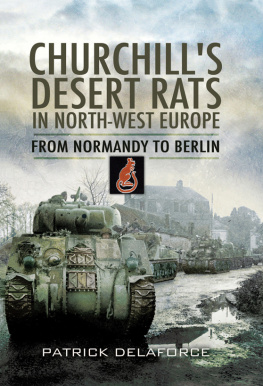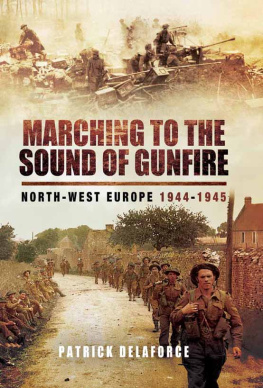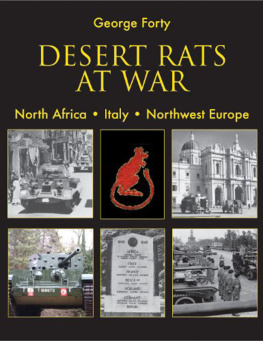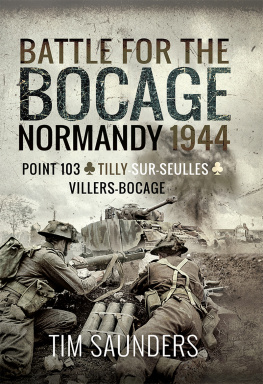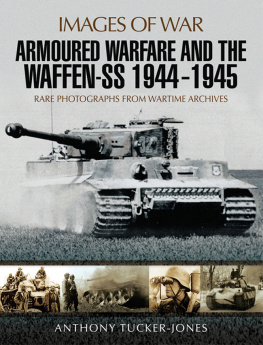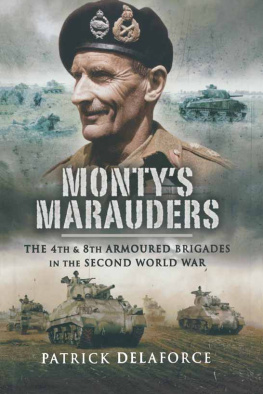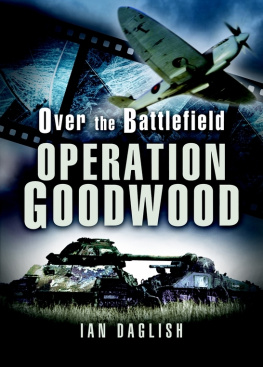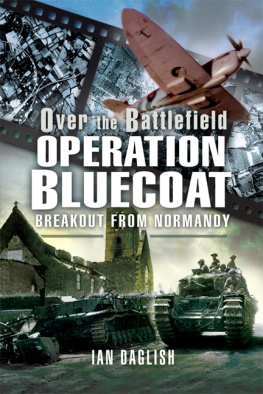CHURCHILLS
DESERT RATS
IN NORTH-WEST EUROPE
CHURCHILLS
DESERT RATS
IN NORTH-WEST EUROPE
From Normandy to Berlin
PATRICK DELAFORCE
First published in the United Kingdom by
Alan Sutton Publishing Ltd in 1994
Republished in this format in 2010 by
Pen & Sword Military
An imprint of
Pen & Sword Books Ltd
47 Church Street
Barnsley
South Yorkshire
S70 2AS
Copyright Patrick Delaforce, 1994, 2010
ISBN 978 184884 111 6
The right of Patrick Delaforce to be identified as Author of this work has been
asserted by him in accordance with the Copyright, Designs and Patents Act 1988.
A CIP catalogue record for this book is
available from the British Library
All rights reserved. No part of this book may be reproduced or transmitted in any
form or by any means, electronic or mechanical including photocopying,
recording or by any information storage and retrieval system,
without permission from the Publisher in writing.
Printed and bound in Great Britain by
CPI Antony Rowe, Chippenham, Wiltshire
Pen & Sword Books Ltd incorporates the Imprints of
Pen & Sword Aviation, Pen & Sword Family History,
Pen & Sword Maritime, Pen & Sword Military,
Wharncliffe Local History, Pen & Sword Select,
Pen & Sword Military Classics, Leo Cooper, Remember When,
Seaforth Publishing and Frontline Publishing
For a complete list of Pen & Sword titles please contact
PEN & SWORD BOOKS LIMITED
47 Church Street, Barnsley, South Yorkshire, S70 2AS, England
E-mail: enquiries@pen-and-sword.co.uk
Website: www.pen-and-sword.co.uk
Contents
First In, Last Out of the Battle
May your glory ever shine! May your laurels never fade! May the memory of this glorious pilgrimage of war which you have made from Alamein, via the Baltic to Berlin, never die. It is a march unsurpassed through all the story of war May the fathers long tell the children about this tale.
These were Winston Churchills dramatic words to the British 7th Armoured Division his favourite on 21 July 1945. They were spoken in the ruins of Berlin, to celebrate the final Victory Parade of the Second World War.
The Desert Rats, who took their name from the long-tailed African desert rodent, wore their insignia of the Jerboa with great pride.
As their GOC, Major-General L.O. Lyne DSO, wrote:
No division has contributed more to the downfall of the Axis Powers and to the total defeat of Germany. The Desert Rats saw service in the Middle East when Italy declared war on us in 1940. They fought with great distinction all through the long campaign which culminated in the victory of Alamein. They took a leading part in the pursuit of Rommel's defeated forces and in the final breakthrough to Tunis.
The division was the first British Armoured Division to land in Europe when it took part in the assault landing at Salerno. It served through the Italian campaign till brought back to England early in 1944 to prepare the great assault on Western Europe.
Churchills Desert Rats is the story of the final campaign from Normandy to Berlin, told by dozens of individual Desert Rats troopers and privates, sergeants, young troop leaders and company commanders. It was a terrible struggle in Normandy, followed by the Break-Out and Great Swan to liberate all of Northern France and Belgium. Ghent was taken, followed by months of dour fighting in the Peel country of Holland, the crossing of the Rhine and the fierce hot pursuit through Germany, the capture of Hamburg and the final entry into Berlin.
The roll-call of famous regiments was deeply inspiring: the Cherry Pickers (11th Hussars, Prince Alberts Own), 8th Kings Royal Irish Hussars, the 1st and 5th Royal Tank Regiments, the Queens Infantry Brigade, 1/7th Queens Royal Surrey (Guildford), 1/6th Queens (Bermondsey) and 117th Queens (Southwark), the Sharpshooters (4th County of London Yeomanry), 1st Battalion of the Rifle Brigade, 3rd and 5th Regiments of Royal Horse Artillery, the Norfolk Yeomanry 65th AntiTank Regiment RA and the Skins (5th Inniskilling Dragoon Guards), who joined in August 1944.
The German army regarded the Desert Rats as the lite of the British Army. Indeed Monty thrust his three desert divisions, including the 7th Armoured, straight into Operation Overlord to push out of the initial vital bridgeheads. But many of the Rats quite rightly thought that they had done far more than their fair share of fighting. They knew all about dying in the desert and in Italy and, having survived, felt little inclination to die in the Normandy bocage, outgunned in their Cromwell tanks by mighty Panzers Tigers and Panthers and the deadly 88mm A/Tank gun. After all there were another dozen British and Canadian divisions waiting in the wings untouched by the scars of war.
This is a story of courage. If you know at first hand of all the dangers from snipers, mines, Nebelwerfers, Panzerfaust, 88mm guns and Panzer fire, it takes enormous guts and instinct for survival to keep pushing down the centre lines. In their long final eleven-month campaign the Rats took grievous casualties. The Sharpshooters in Normandy and the Queens Brigade in Holland had to be merged, even disbanded, because of their losses. The division was stretched to the very limits of endurance but still, as Monty put it, they were in at the kill.
Churchills Desert Rats is dedicated to the memory of the thousands of Rats who are buried in well-tended, green-pastured cemeteries.
I was fortunate to fight with 11th Armoured Division, the Black Bull, from Normandy to the Baltic with 13th RHA, and then on their disbandment, I moved in late 1945 to spend eighteen months with the Desert Rats as a troop commander in 3rd RHA. In all the great battles in north-west Europe the Black Bull and the Desert Rat fought side by side against a ferocious determined foe. We won.
If there are errors of names, dates and places, they are mine alone. At the end of the book I have referred with many thanks to the score or two of Sharp End soldiers usually with sand in their shoes who have made this book so interesting.
The First World War song, Old soldiers never die, they only fade away, may have been applicable to the Desert Rats, but their own motto was An old soldier is a cautious soldier, that is why he is an old soldier.
Made famous by Jons Two Types cartoons and loaded with battle honours they arrived back in the UK from Italy on 7 January 1944. A race apart with brown faces (and knees), to many people they appeared rude, cocky and arrogant a law unto themselves. They spoke a foreign language with strange words like shufti, shai, maleesh, imshi, sayeda, buckshee, and of course ackers and bints! They sang peculiar songs such as the haunting Wehrmacht marching song Lili Marlene, albeit with unusual and vulgar words! Their army costume was bizarre gaudy coloured silk scarves, brilliant pullovers, and a peculiar array of headgear. Their officers wore scuffed brothel-creeper suede shoes, highly coloured corduroy trousers, and some sported luxuriant moustaches and carried fly whisks. They all claimed still to have sand in their shoes in East Anglia. The pale-faced British army who had not yet soldiered outside Britain winced at the arrival of these jaunty, swashbuckling Desert Rats. But war-weary Britain made much of the victors of Alamein, Tobruk, Benghazi, Tripoli, Mareth and Tunis, and more recently Salerno, Naples and Volturno.
Monty had a little div
He called the Desert Rats

